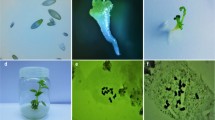Summary
The effect of colchicine concentration, and the mode and time of colchicine application in doubling the chromosomes of haploid Brussels sprout plants was assessed by scoring treated plants for the presence of diploid flowers and seed set after self-pollination.
When colchicine treatments were applied after the plants had been vernalised, using 2 dose rates and 3 methods of application, only 38.1% became doubled and only 13.8% produced seed. Treatment with 0.1% colchicine with or without the addition of 2% dimethyl sulphoxide gave doubling rates similar to those reached with 0.05% colchicine, but resulted in more damage to the apices.
When 0.05% colchicine solution was injected into the plants' apices at varying times during vernalisation, the rate of doubling was 71.2% on average and 50.7% of plants gave seed on selfing.
Overall doubling rates of plants where the apex was easily accessible were 79.0%, while for plants with dense terminal heads they were 35.0% and for plants with visible buds 31.4%.
Similar content being viewed by others
References
GlandA., 1981. Doubling chromosomes in interspecific hybrids by colchicine treatment. Cruciferae News-letter 6: 20–22.
HoffmannF., E.Thomas & G.Wenzel, 1982. Anther culture as a breeding tool in rape. II. Progeny analyses of andogenetic lines and induced mutants from haploid cultures. Theor. Appl. Genet. 61: 225–232.
Jensen, C. J., 1974. Chromosome doubling techniques in haploids. In:K. J. Kasha (Ed.), Haploids in higher plants: Advances and potential, p. 153–190. University of Guelph.
KeilH. L., 1965. DMSO shows great promise as a carrier of agricultural toxicants. Agr. Chem. 20: 23–24.
NelderJ. A. & R. W. M.Wedderburn, 1972. Generalised linear models. J. Roy. Stat. Soc., series A 135: 370–384.
OckendonD. J., 1984. Anther culture in Brussels sprouts (Brassica oleracea var.gemmifera). I. Emryo yields and plant regeneration. Ann. appl. Biol. 105: 285–291.
OckendonD. J., 1986. Utilisation of anther culture in breeding Brussels sprouts. In: W.Horn, C. J.Jensen, W.Odenbach & O.Scheider (Eds), Genetic manipulation in plant breeding, p. 265–272. Walter de Gruyter, Berlin.
Ockendon, D. J. & L. Currah, 1985. Use of anther culture to produce homozygous lines of Brussels sprouts. Proc. Better Brassicas '84 Conference, p. 27–31.
SandersH. & J. W.Hull, 1970. Dimethyl sulphoxide as an adjuvant of colchicine in the treatment ofRubus seeds and shoot apices. Hort. Sci. 5: 111–112.
WenzelG., F.Hoffmann & E.Thomas, 1977. Anther culture as a breeding tool in rape. I. Ploidy level and phenotype of androgenetic plants. Z. Pflanzenzüchtg 78: 149–155.
Author information
Authors and Affiliations
Rights and permissions
About this article
Cite this article
Currah, L., Ockendon, D.J. Chromosome doubling of mature haploid Brussels sprout plants by colchicine treatment. Euphytica 36, 167–173 (1987). https://doi.org/10.1007/BF00730660
Received:
Issue Date:
DOI: https://doi.org/10.1007/BF00730660




